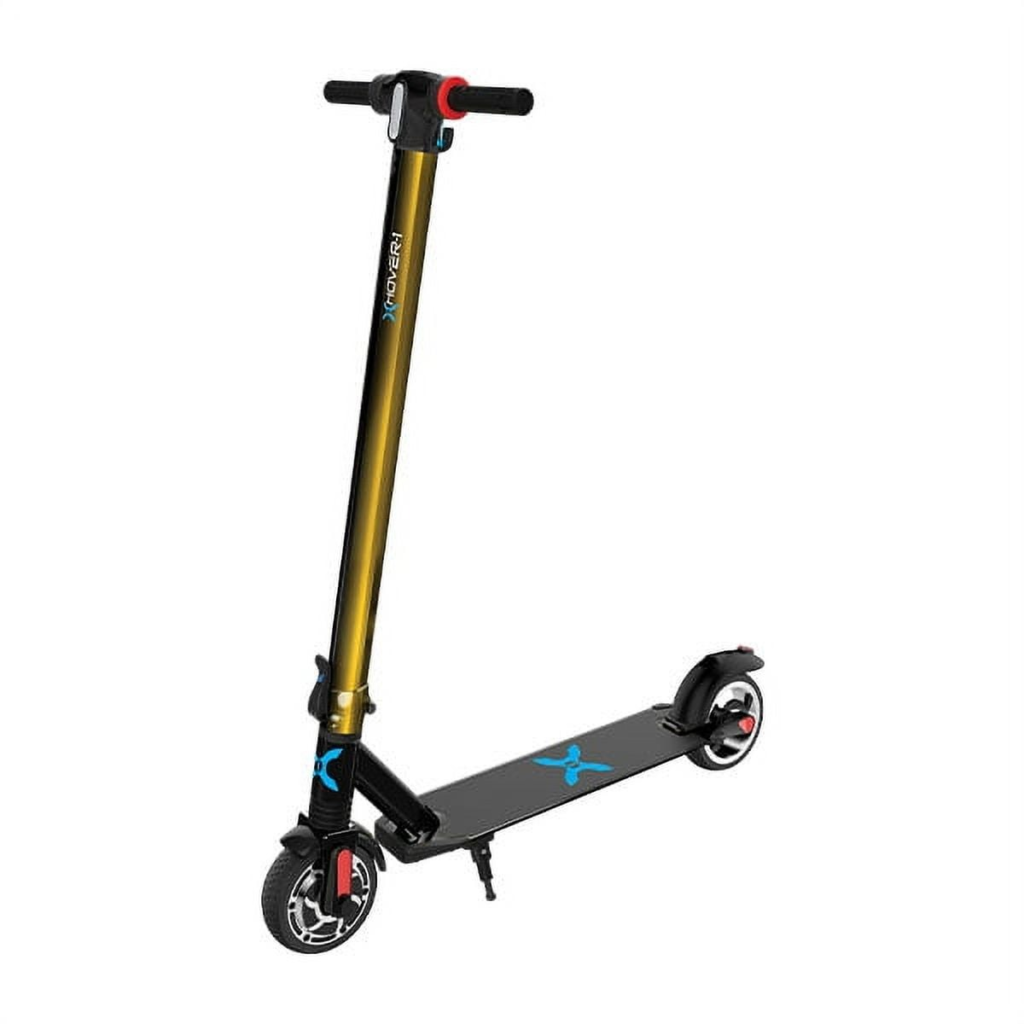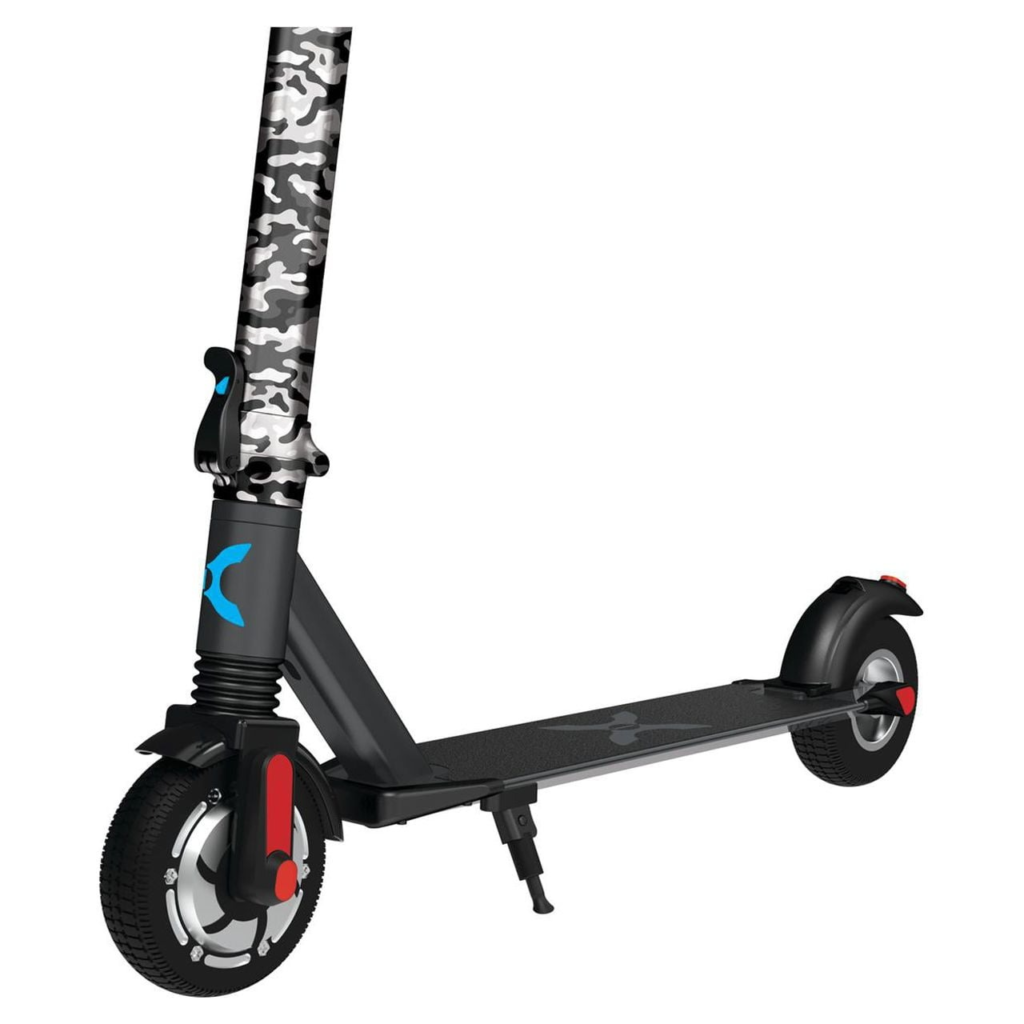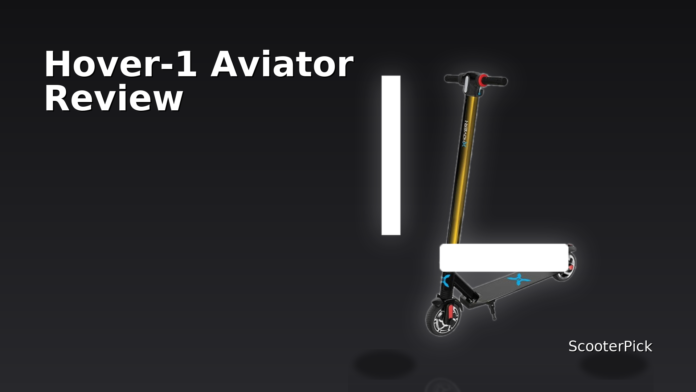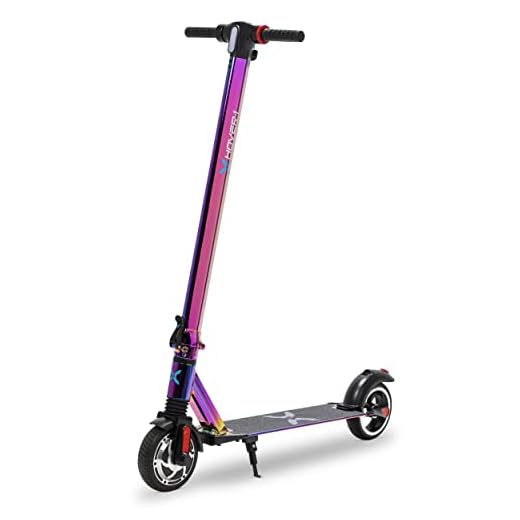If you want a light, simple scooter for short daily hops, the Hover-1 Aviator is one of the brand’s most approachable models. In this Hover-1 Aviator review, I break down build quality, power, range, and real-world behavior so you know where it shines and where it trades off. For reference, you can also check the product page for the Hover-1 Aviator on ScooterPick.com. This compact folder targets first-time riders, students, and anyone who values portability over brute power.
Key Specifications
Below is a concise, rider-focused snapshot of the Aviator’s core details in both US and metric units, grouped by what matters on the road.
| Block | Item | Details |
|---|---|---|
| General | Model | Hover-1 Aviator |
| Intended use | Urban/short-commute, smooth pavement | |
| Rider height range | ~4’9”–6’2” (145–188 cm) | |
| Max load | 220 lb (100 kg) | |
| Water resistance | Not officially rated (avoid heavy rain/puddles) | |
| Performance & Power | Motor | 300 W rear hub (brushless) |
| Peak output | ~350–400 W (short bursts) | |
| Top speed | Up to ~15 mph (24 km/h) | |
| Typical cruise | 9–13 mph (15–21 km/h), depending on terrain | |
| Hill capability | Light slopes only (~5–6% with momentum) | |
| Charging & Electrical | Battery | 36 V, approx. 4.0–5.0 Ah (144–180 Wh class) |
| Charger output | 42 V, ~1.0–1.5 A | |
| Charge time | ≈4–5 hours from near empty | |
| Display | Basic LED (speed, battery, mode) | |
| Lights | LED headlight, rear light; reflectors on deck/stem | |
| Build & Dimensions | Frame | Aluminum alloy stem & deck, polymer fenders |
| Tires | 6.5 in solid rubber (non-pneumatic) | |
| Brakes | Electronic (regen) front + rear foot fender brake | |
| Deck size | ~17.5 x 5.5 in (44.5 x 14 cm) usable surface | |
| Handlebar height | ~39 in (99 cm) from deck | |
| Unfolded (L×W×H) | ~43 × 17 × 44 in (109 × 43 × 112 cm) | |
| Folded (L×W×H) | ~43 × 17 × 19 in (109 × 43 × 48 cm) | |
| Scooter weight | ≈23–26 lb (10.5–11.8 kg) | |
| Safety & Control | Ride modes | 2–3 modes (Beginner/Standard; sometimes Sport) |
| Bell | Integrated on handlebar (varies by batch) | |
| Kick-to-start | Yes (safer for new riders) | |
| Stem latch | Single lever with safety clip | |
| Features & Extras | Cruise Control | Not available on most batches |
| App support | Not supported (simple, ride-and-go) | |
| Kickstand | Side stand, spring-loaded | |
| Reflectors | Side and rear reflectors for visibility | |
| Warranty & Compliance | Warranty | Limited 90-day manufacturer warranty (typical) |
| Charger safety | UL-certified charger | |
| Local rules | Follow local e-scooter regulations |
Note: Manufacturers occasionally adjust small details (tires, latches, or LED cluster styles) between production runs. Always check the label on your unit.
Design & Build Quality
The Aviator’s design leans on simplicity. The profile is clean, the hinge is straightforward, and the deck is slim. That approach yields a scooter you can lift one-handed and stow under a desk or in a trunk without drama. The aluminum stem keeps weight in check while maintaining decent torsional rigidity for a lightweight frame. Because the deck is narrow, your stance is naturally single-file. That stance works fine on short trips; however, longer rides may leave your back foot seeking more room.
Fit and finish are consistent with entry-level commuter gear. Panels sit flush, the wiring is reasonably tucked, and the latch hardware feels more robust than it looks at first glance. As with many compact folders, you will see a little stem flex if you bounce the front wheel over cracks. It’s not alarming, yet it reminds you that this is a light commuter, not a heavy performance rig.
The folding mechanism uses a single lever plus a safety clip. It’s quick to learn and secure when properly engaged. The latch tolerances on small scooters can loosen slightly after months of folding cycles, so it’s smart to check the clasp tension every few weeks. Fortunately, the Aviator’s hinge area is accessible, and adjustments don’t require specialized tools.
Tires are 6.5-inch solid rubber. Solids remove puncture anxiety, which is valuable for new riders and students. They also transfer more vibration than pneumatic tires. On smooth sidewalks and well-paved bike lanes, they roll fine. On coarse asphalt or tile with expansion joints, you’ll feel chatter through the deck and handlebar. This is normal for solids at this size, and it’s a trade-off: zero flats, more road buzz.
Lighting is basic but sensible for neighborhood speeds. The headlight is positioned high on the stem and makes you visible. It’s okay for being seen but modest for seeing far ahead. At 10–12 mph you can still react to surface changes, yet on unlit paths you’ll want supplemental lighting. The rear light and reflectors help with side and back visibility. As always, add a reflective strap or clip-on light if you ride at dusk.
Overall, the build delivers on its mission: compact, reliable, and easy to live with. If you keep bolt checks in your routine and treat the folding parts with care, it holds up well for daily short trips.

Motor, Power & Acceleration
A 300-watt rear hub drives the Aviator. For flat urban terrain, that’s enough to hit neighborhood speeds quickly and maintain an easy cruise. Throttle mapping is gentle at the start. You get a small ramp-up before stronger pull arrives. That tuning helps beginners avoid jerky getaways and contributes to predictable launches at crosswalks.
From a standstill, the Aviator prefers a kick-to-start. Give it a small push, roll the throttle, and it takes over smoothly. In Standard mode, acceleration feels relaxed up to about 10 mph (16 km/h), then settles into a steady surge. A higher mode, if enabled on your unit, trims the time to reach 15 mph (24 km/h) but won’t turn the scooter into a sprinter. The motor is quiet, with a soft whine typical of small brushless hubs.
On gentle grades, pace drops a bit yet remains usable. Expect to roll at 7–9 mph (11–14 km/h) on a sustained mild climb if you began with momentum. On short rises, the motor’s burst can crest without drama. On steeper sections, you’ll feel it working, and your speed may dip to walking pace. That limitation is part of the lightweight package: less mass to carry, but also less torque.
The rear-hub layout keeps traction predictable. When you accelerate out of a corner, the rear tire pushes smoothly without tugging the stem. Because the tires are solid and small, avoid hard throttle over rippled surfaces; you’ll keep the contact patch happier and the chassis calmer.
In brief, power delivery meets the use case. It’s built for short commutes, campus loops, and neighborhood errands. If your ride involves long climbs or you demand brisk acceleration, you’ll want a bigger motor class. If you want reliable, predictable pull on flat ground, the Aviator checks that box.
Battery, Range & Efficiency
The Aviator carries a 36-volt pack in the ~4.0–5.0 Ah range (144–180 Wh class). In practical terms, that energy capacity supports a handful of short trips or a modest round-trip commute with a top-up in between. On flat ground at 9–12 mph cruise, a lightweight rider can approach the upper end of the claimed range. Add hills, stops, headwinds, or a heavier rider, and real-world distance shrinks accordingly.
Plan with a buffer. For example, if your daily loop totals 4–6 miles (6.5–10 km), you can complete it confidently at relaxed speeds. If you ride faster, climb often, or weigh more than average, expect around 3–4 miles (5–6.5 km) per charge, with a comfortable margin. Small packs are forgiving when you manage expectations, and they reward smooth riding.
Efficiency hinges on throttle discipline and route choice. Hold a steady pace rather than full-throttle sprints, and you’ll gain meaningful minutes of extra runtime. Keep your tires clean and free of embedded stones, as drag from roughened tread on small solids costs watt-hours you can’t spare. In cooler weather, lithium batteries deliver less energy; you may see a range drop as temperatures fall. Store the scooter indoors when possible, and avoid charging in freezing conditions.
The battery indicator uses a simple bar system. The top bar lingers, then bars decline more quickly as you approach the bottom third. That’s normal for many scooters and reflects how voltage drops under load. Treat the last bar as reserve. If you need to stretch the trip, drop into the lower ride mode and reduce speed by a couple of mph.
Charging is straightforward: plug the 42 V charger into the port, wait ~4–5 hours for a near-empty pack, and let it cool before riding hard. If you commute daily, partial charges work fine. Lithium-ion chemistry favors shallow cycles, so topping up from 40–60% back to 90% is easy on the pack. Once a month, allow a full charge to help the BMS balance cells.
In short, the Aviator’s battery suits short, frequent rides. It encourages a calm cruising style and rewards riders who plan their week with a simple desk-side top-up routine.
Ride Quality, Handling & Comfort
Lightweight scooters feel agile, and the Aviator is no exception. The short wheelbase responds quickly to steering inputs, and the low mass makes quick turns and U-turns surprisingly fun at low speeds. On crowded paths, that agility helps you thread gaps and avoid last-second surprises.
Comfort depends heavily on surface quality. On smooth pavement, the ride is pleasant even with solid tires. Over broken asphalt, you’ll feel buzz. The vibration doesn’t overwhelm, yet it reminds you that solids trade plushness for puncture proofing. If your route includes expansion joints, step over them with soft knees and a relaxed grip. A slight bend in the elbows also reduces the chatter you feel in your wrists.
The deck sits moderately low, which aids stability and makes foot switches effortless. Because the deck is narrow, experiment with foot angles. Many riders prefer front foot at ~30–45° and rear foot inline to keep hips comfortable. Take a minute to test what your knees and lower back prefer; a good stance goes a long way toward making 15–20 minute rides feel easy.
At speed, the chassis remains composed as long as the surface stays even. On shallow downhill stretches, keep your weight a touch rearward and your eyes farther down the path. The small front wheel communicates surface changes clearly, which is helpful for beginner confidence. It also means you should avoid potholes and large cracks. The scooter can’t float over the same debris that larger, pneumatic-tire models can manage.
Noise levels are low. Aside from the gentle motor whine, most rattles come from accessories. Tighten the bell clamp and check the kickstand bolt periodically. A two-minute check each weekend preserves that quiet, tight feel.
The net result is a nimble city companion. It favors riders who prioritize control and predictability over plush suspension. Treat rough patches with respect, and the Aviator pays you back with easy steering and low effort.

Braking & Safety Features
Braking combines electronic (regen) assistance at the front and a rear foot-actuated fender brake. At neighborhood speeds, that pairing is effective. The electronic brake engages smoothly when you roll off the throttle or tap the brake control, taking the first bite of speed. The rear foot brake then adds mechanical stopping power and lets you tune final deceleration.
Practice matters. Because the rear foot brake depends on how firmly you press, do a few runs on an empty path to learn the feel. Start at 8–10 mph, test the electronic brake alone, then layer in the foot brake to shorten stopping distance. Keep your hips low and your weight balanced. On dusty or wet surfaces, modulate pressure to prevent skids, especially with solid tires.
The headlight and rear light improve your conspicuity. For true night riding, add a helmet light that points where you look. Side reflectors help intersections, and a bar-mounted bell gives you a friendly alert in shared spaces.
Kick-to-start is a quiet safety win. It prevents accidental takeoffs when someone squeezes the throttle while stationary. The drive won’t engage until the scooter rolls, and that keeps beginners safer at crosswalks and curb cuts.
Finally, inspect your hinge and stem clamp before rides. Give the bar a quick forward-back tug; you should feel minimal play. If you detect movement, adjust the latch and safety clip. That habit maintains steering precision and reduces creaks over time.
Portability & Daily Usability
Portability is the Aviator’s superpower. At roughly 23–26 lb (10.5–11.8 kg), most adults can carry it up a flight of stairs without strain. The folded package is slim and easy to angle through doorways. In a hatchback trunk, it fits side-by-side with a backpack or groceries. On public transit, the narrow deck width makes it less awkward in aisles.
The folding action is fast. Drop the lever, guide the stem down, and the latch secures to a deck hook. Because the hook angle is shallow, it’s smart to lift from the stem with one hand while steadying the deck with the other during longer carries. That prevents the latch from bouncing loose. After a week you’ll do it without thinking.
Storage is equally simple. Under-desk parking at the office is a core use case. The kickstand is stable on flat floors, and the small tires don’t track much dirt if you avoid puddles. In apartment hallways, the folded length tucks along the wall. Add a soft sleeve or foam strip under the stem to prevent scuffs against furniture when you swing it inside.
Daily usability also includes the basics: charging, lock-up, and quick checks. The charging port is accessible, and cable strain relief is decent. Use a short U-lock or a compact folding lock around a fixed rack; thread through the deck opening or rear frame area. Lightweight frames are easier targets than heavy scooters, so lock thoughtfully and never leave it outside overnight.
As a last note, this scooter’s low mass and small wheels make it friendly for multi-modal commutes. If your routine blends bus or rail with a mile or two of scooting, the Aviator slots in naturally.
Features, App & Extras
The Aviator keeps features minimal to stay affordable and light. There’s no companion app to learn, no pairing steps to troubleshoot, and no extra settings screens to scroll. You pick a ride mode on the bar, read speed and battery on the LED cluster, and go. That simplicity lowers the barrier for first-time riders and reduces points of failure.
Cruise control is not present on most batches. While some riders enjoy a speed-hold feature on long straights, the absence here means you’ll keep a finger on the throttle. For short urban legs, that’s fine. For longer straight runs, you’ll notice the difference. The upside is fewer accidental speed holds in congested areas.
The lighting package is modest yet practical. The headlight sits high and casts a usable beam for being seen. The rear light improves visibility when you brake or when cars approach from behind. Reflectors round out side attention. If you ride at dusk often, consider an inexpensive strap light on the stem to enhance lateral visibility.
Other thoughtful touches include a bell on some units, a sturdy kickstand, and a clear battery readout. None of those feels premium, yet each helps a new rider feel confident and in control without opening a manual.

Charging Experience & Maintenance
Charging is plug-and-park. Expect ~4–5 hours from a low battery. If you ride daily, it’s convenient to top up when you arrive at work or during dinner at home. Lithium-ion packs prefer partial charges, so don’t worry about waiting for zero; shallow cycles are gentle on the cells.
Routine maintenance is quick:
- Weekly: Check stem latch tension, look for any bolt migration at the handlebar clamp, and ensure the kickstand stays tight. Wipe the deck clean.
- Biweekly: Inspect tires for embedded glass or metal. Solids won’t puncture, but debris can chew the surface and add drag.
- Monthly: Verify brake response. Practice an emergency stop in a safe area to keep your timing sharp and confirm nothing has changed.
- Seasonal: If you won’t ride for several weeks, store the scooter around 50–70% battery, in a cool, dry place. Avoid leaving it in a hot car or unheated shed through a freeze.
Because there’s no app, you won’t update firmware or tweak acceleration curves. The flip side is fewer variables to manage. If something squeaks, a dab of silicone on plastic-to-plastic interfaces (not on the brake surfaces) quiets the noise. Keep lubricants away from the tire tread and braking areas.
Finally, treat water with caution. Without an official ingress rating, avoid heavy rain and deep puddles. Wipe the scooter dry if you get caught in a sprinkle, and don’t charge until the ports and connectors are fully dry.
Who the Hover-1 Aviator Is For
This scooter fits riders who value portability and simplicity over raw speed:
- First-time owners who want low commitment and a gentle learning curve.
- Students navigating campus with elevators and stairs.
- Short-hop commuters covering a couple of miles each way on smooth pavement.
- Errand runners who want a quick store run without moving a car.
It’s less ideal if you face long, steep hills, rough pavement, or daily distances over 6–7 miles (10–11 km) without access to a charger. It’s also not designed for aggressive riding or high-speed descents. If you need plush suspension, large pneumatic tires, or 20+ mph cruising, consider a larger category.
That said, within its lane, the Aviator is approachable, quiet, and easy to keep. Many riders use it as a gateway scooter: learn skills, refine route choices, and later decide whether to graduate to more power.
If you’re cross-shopping similar entry models from the brand, also consider the Hover-1 Edge 2.0 to see how its format compares to the Aviator.
Value for Money & Verdict — Hover-1 Aviator review Takeaways
Value lives at the intersection of what you need and what you don’t. The Aviator strips away complexity and preserves the essentials for urban errands. You get a reliable 300 W hub, a compact fold, simple controls, and a weight you can carry without dreading stairs. You don’t get suspension, an app, or large pneumatic tires. For its mission, that trade-off makes sense.
On the road, it behaves predictably. Starts are smooth, low-speed steering is easy, and stops are controllable once you practice the rear foot brake. Range is modest by design, which encourages thoughtful planning and regular top-ups. If your week consists of short morning and evening hops, the battery and charge routine feel natural.
The big question is whether you’re the right rider for this package. If you want a fuss-free scooter to shrink a short commute, the Aviator earns a spot on your shortlist. If you want hills crushed and rough asphalt tamed, step up in class. Either way, the Aviator makes a clear promise: keep it light, keep it simple, and it will keep up.
Pros & Cons
Pros
- Very portable and easy to carry up stairs
- Simple interface with clear speed/battery readout
- Predictable throttle and gentle launch for new riders
- Solid tires eliminate flats and routine inflation
- Quick, uncomplicated folding mechanism
- Quiet motor and low maintenance routine
- Kick-to-start safety reduces accidental takeoffs
Cons
- Modest range; best for short, planned trips
- Solid 6.5″ tires transmit vibration on rough surfaces
- Rear foot brake requires practice for best stopping
- Limited hill performance; slows on steeper grades
- No app or cruise control for long straight runs
- Headlight is “be seen” more than “see far”
- Not water-rated; avoid heavy rain or puddles
Price
FAQs
How fast does the Hover-1 Aviator go?
It tops out around 15 mph (24 km/h) in favorable conditions. Expect cruise speeds closer to 9–13 mph (15–21 km/h) on typical city paths.
What is the real-world range?
Plan on several miles per charge for everyday riding. Lightweight riders on flat routes at relaxed speeds can stretch it, while hills and headwinds reduce distance.
Can it climb hills?
It handles gentle grades with momentum. On steeper or prolonged climbs, speed will drop, and you may need to kick assist.
Is the Hover-1 Aviator waterproof?
It’s not officially water-rated. Avoid riding in heavy rain or through standing water, and dry the scooter before charging.
How does the braking feel?
You get smooth electronic braking to start, then you add the rear foot brake for stronger stops. Practice a few runs to learn the modulation.
Does it have cruise control or an app?
No. The Aviator keeps things simple with on-board controls only.
Is this a good beginner choice? (Hover-1 Aviator review perspective)
Yes, if your rides are short and surfaces are smooth. It’s light, predictable, and easy to carry, which makes learning less intimidating.
Final Notes on Fit & Expectations
Choosing the right scooter is about matching your routes and habits to a frame’s strengths. The Aviator’s strengths are portability, approachability, and low upkeep. If you ride short distances, appreciate a gentle throttle, and want a straightforward daily companion, it fits well. If you need long range, plush comfort, or serious hill torque, it’s wiser to look at larger, heavier platforms.
Also, remember that small, solid tires reward smooth lines. Scan ahead, take shallow angles over seams, and keep your knees loose. Those habits make the ride calmer and extend the scooter’s life.
Lastly, mind your charging routine and storage. Treat the battery kindly, keep the hinge tuned, and the Aviator will return the favor with months of easy rides.



